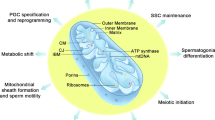Abstract
In early spermatids of Urodeles the chromosome segments bearing constitutive heterochromatin are localized in one half of the round nucleus; this region becomes the basal part of the long nucleus of the spermatozoon. The euchromatic chromosome segments extend toward the anterior nuclear pole in a bouquet configuration (Macgregor and Walker, 1973). In the course of spermiohistogenesis, one of the heterochromatic regions (the acrosomal chromocenter) migrates from the basal part to the anterior half of the spermatid nucleus. This heterochromatic block is identical with a species-specific, definite C-band in the karyotype. This relationship between the acrosomal chromocenter and a specific chromosomal C-band was established in Triturus cristatus, T. marmoratus, T. alpestris and Cynops pyrrhogaster. In closely related species this particular C-band lies on similar chromosomes. — While the spermatid nucleus still retains its round shape the acrosomal chromocenter despiralizes into a long heterochromatic thread (acrosomal thread). Precisely at the position of this thread the nucleus evaginates and acquires a pear-like shape. During the elongation of the nuclear protrusion the acrosomal thread remains associated with the anterior end. At termination of spermiogenesis it lies closely below the acrosome in the tip of the spermatozoon. Spontaneous aberrations which affect the acrosomal chromocenter or the thread lead to the development of spermatozoa with defective tips. — Several euchromatic segments, interspersed between the heterochromatic segments, can be recognized in the completely despiralized acrosomal thread. Genes responsible for the morphogenetic activities of both, the acrosomal chromocenter and the acrosomal thread, in the development of the spermtip, might be localized in these interspersed euchromatic segments. The existence in higher vertebrates of an acrosomal chromocenter or an equivalent chromosomal region is discussed.
Similar content being viewed by others
References
Arrighi, F.E., Hsu, T.C.: Localization of heterochromatin in human chromosomes. Cytogenetics 10, 81–86 (1971)
Bailly, S., Guillemin, C., Labrousse, M.: Comparaison du nombre et de la position des zones spécifiques révélées sur les chromosomes mitotiques de l'Amphibien Urodèle Pleurodeles waltlii Michah, par les techniques de coloration au colorant de Giemsa et à la moutarde de quinacrine. C.R. Acad. Sci. (Paris) 276, 1867–1869 (1973)
Barlow, P.W., Sherman, M.I.: Cytological studies on the organization of DNA in giant trophoblast nuclei of the mouse and the rat. Chromosoma (Berl.) 47, 119–131 (1974)
Barr, H.J., Ellison, J.R.: Ectopic pairing of chromosome regions containing chemically similar DNA. Chromosoma (Berl.) 39, 53–61 (1972)
Barsacchi, G., Gall, J.G.: Chromosomal localization of repetitive DNA in the newt, Triturus. J. Cell Biol. 54, 580–591 (1972)
Evans, E.P., Breckon, G., Ford, C.E.: An air-drying method for meiotic preparations from mammalian testes. Cytogenetics 3, 389–294 (1964)
Heitz, E.: Über α-und β-Heterochromatin sowie Konstanz und Bau der Chromomeren bei Drosophila. Biol. Zbl. 54, 588–609 (1934)
Hsu, T.C., Cooper, J.E.K., Mace, M.L., Brinkley, B.R.: Arrangement of centromeres in mouse cells. Chromosoma (Berl.) 34, 73–87 (1971)
Hutchison, N., Pardue, M.L.: The mitotic chromosomes of Notophthalmus (=Triturus) viridescens: localization of C banding regions and DNA sequences complementary to 18S, 28S and 5S ribosomal RNA. Chromosoma (Berl.) 53, 51–69 (1975)
Lantz, L.A.: Hybrids between Triturus cristatus Laur. and Triturus marmoratus Latr. Proc. zool. Soc. (Lond.) 117, 247–258 (1974)
Macgregor, H.C., Horner, H., Owen, C.A., Parker, I.: Observations on centromeric heterochromatin and satellite DNA in salamanders of the genus Plethodon. Chromosoma (Berl.) 43, 329–348 (1973)
Macgregor, H.C., Kezer, J.: The chromosomal localization of a heavy satellite DNA in the testis of Plethodon c. cinereus. Chromosoma (Berl.) 33, 167–182 (1971)
Macgregor, H.C., Walker, M.H.: The arrangement of chromosomes in nuclei of sperm from Plethodontid salamanders. Chromosoma (Berl.) 40, 243–262 (1973)
Nardi, I., Ragghianti, M., Mancino, G.: Karyological differentiation within the superspecies Triturus cristatus (Amphibia Urodela). Atti XXXIX Conv. UZI. Boll. Zool. 37, 511–512 (1970)
Nardi, I., Ragghianti, M., Mancino, G.: Banding patterns in newt chromosomes by the Giemsa stain. Chromosoma (Berl.) 40, 321–331 (1973)
Natarajan, A.T., Ahnström, G.: Induced chromosomal aberrations and heterochromatin. In: Modern aspects of cytogenetics; constitutive heterochromatin in man (R.A. Pfeiffer, ed.), pp. 201–213. Symposia Medica Hoechst 6. Stuttgart-New York: Schattauer 1973
Natarajan, A.T., Gropp, A.: A fluorescence study of heterochromatin and nucleolar organization in the laboratory and tobacco mouse. Exp. Cell Res. 74, 245–250 (1972)
Phillips, D.M.: Spermiogenesis. New York-London: Academic Press 1974
Picheral, B.: Structure et organisation du spermatozoide de Pleurodeles waltlii Michah. (Amphibien Urodèle). Arch. Biol. (Liège) 78, 193–221 (1967)
Ragghianti, M., Bucci Innocenti, S., Mancino, G.: Bandeggiatura indotta da ≪C-, G-e Q-staining methods≫ e pattern di replicazione dei cromosomi di Triturus. Rend. Accad. naz. Lincei 55, 764–770 (1973)
Schmid, M., Krone, W.: Acrosomal chromocentre in newt spermiogenesis. Nature (Lond.) 257, 795–797 (1975)
Schmid, M., Vogel, W., Krone, W.: Attraction between centric heterochromatin of human chromosomes. Cytogenet. and Cell Genet. 15, 66–80 (1975)
Spurway, H.: Genetics of specific and subspecific differences in european newts. Symp. Soc. exp. Biol. 7, 200–237 (1953)
Wolf, K., Quimby, M.C.: Amphibian cell culture: permanent cell line from the bullfrog (Rana catesbeiana). Science 114, 1578–1580 (1964)
Author information
Authors and Affiliations
Additional information
Presented in partial fulfilment of the requirements for the degree of Doctor rer. nat., University of Ulm
Rights and permissions
About this article
Cite this article
Schmid, M., Krone, W. The relationship of a specific chromosomal region to the development of the acrosome. Chromosoma 56, 327–347 (1976). https://doi.org/10.1007/BF00292954
Received:
Accepted:
Issue Date:
DOI: https://doi.org/10.1007/BF00292954



